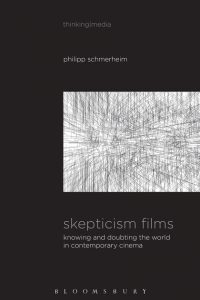 Skepticism Films. Knowing and Doubting the World in Contemporary Cinema. New York: Bloomsbury, 2015 (= thinking | media; 2)
Skepticism Films. Knowing and Doubting the World in Contemporary Cinema. New York: Bloomsbury, 2015 (= thinking | media; 2)
Skepticism Films. Knowing and Doubting the World in Contemporary Cinema introduces skepticism films as updated configurations of skepticist themes that exemplify the pervasion of philosophical ideas in popular culture. As will be shown, a detailed analysis of skepticism films and of the general relation between philosophical skepticism and cinema contributes to a better understanding of the dynamic interplay between film and philosophy.
The first part of the book defends a general, pluralistic film-philosophical position according to which films can be, but need not be, expressions of philosophical thought in their own right. The second part investigates the role of skepticist ideas in philosophical reflection on the medium of film by critically discussing the works of the film-philosophers Stanley Cavell, Gilles Deleuze, Josef Früchtl, Patricia Pisters, and D.N. Rodowick. The concluding parts of the book explore varieties of skepticism films as an integral phenomenon of contemporary cinema culture with the help of detailed case studies of films such as The Truman Show, Inception, Matrix, Vanilla Sky, The Thirteenth Floor, and Shutter Island.
Skepticism Films. Knowing and Doubting the World in Contemporary Cinema has been published with Bloomsbury Publishing in November 2015. The link to the publisher’s website is here; an online reading sample can be found here.
More information on the book here.
 Kinder- und Jugendfilmanalyse. Konstanz: UVK, 2013 (= UTB 3885) [with Tobias Kurwinkel]
Kinder- und Jugendfilmanalyse. Konstanz: UVK, 2013 (= UTB 3885) [with Tobias Kurwinkel]
This German-language introduction to children’s film analysis provides an overview of the definition, genres and history of films for children and young adults, with detours into topics such as adaptation, children’s television and family entertainment films. The second part of the book outlines methods and tools for children’s film analysis, based on a detailed examination of the peculiarities of children and young adults as film spectators. A chapter on writing film analyses provides students with guidelines for conducting their own systematic analysis of a film. In the third part of the book, case studies of The Hunger Games, Madita, Ratatouille, Tarzan 2 and Paranoid Park, all of which are written by other film scholars, exemplify our approach to film analysis. An extensive glossary and a commented bibliography at the end of each chapter adds to the use value of the book.
Reviews
STUBE • PH Ludwigsburg • KinderundJugendfilmKorrespondenz • Film & TV Kameramann • tv diskurs • ph akzente • IASLonline • 1000 und 1 Buch • Kinder- und Jugendliteraturforschung 2013/2014
